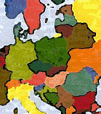|
 Constructing Boundaries
Constructing Boundaries
Sanda Farcaş
On 24 April 2001, Romanian President Ion Iliescu promulgated a new law on local public administration. The law attempts to place greater responsibility in the hands of regional administrative units—the village, town, city and county—rather than in the hands of the central administration.
However, there are concerns that the law will act as a mechanism for imposing and supporting a "boundary" between the ethnic groups. If so, what kinds of internal and external categorizations help build these boundaries and how does society activate them?
To solve these questions various subjects have to be considered over and above the legal spectrum. This analysis uses information from three national daily Romanian newspapers: Curentul, Adevărul and Cotidianul. These newspapers were chosen largely because of the level of attention they gave to the new law of administration.
This analysis is approached from the theoretical perspective of Fredrik Barth, who examined the relational nature of groups in society and explored the ways in which a group (ethnic or not) sets up and manages its relations with another group.
Internal and external construction
There were five key stages leading to the promulgation of the law: the vote by the Chamber of Deputies(18 January 2001), the referral to the Mediation Parliamentary Commission (24 January), the decision by both Parliamentary Chambers to debate the content of the project in a joint session(8 March), the claim it was unconstitutional and the subsequent submission to the Constitutional Court for additional revisions (19 March), and the recognition by the Constitutional Court of the legitimate character of the text, followed by it being sent to the President to be promulgated (19 April).
Following the progress of the law offers the opportunity to furhter examine the nature of the ethnic boundary construction in Romania and the related reactions which are most frequently met under these circumstances. Ethnic boundaries can therefore be defined in two ways: from the inside and, respectively, the outside of the ethnic group.
The majority of sources that question ethnic boundary construction are laregely external to the ethnic groups in question. In addition, they are spread across a large scale of actors, beginning with those who adopt easily anticipated stances like those of the extreme right-wing leader of the Greater Romania Party (PRM), Corneliu Vadim Tudor, and other members of the PRM and ending with liberal and democratic MPs such as Mugur Isărescu.
For the first category of responses (ie external), the conclusive statement on the local public administration law by PRM Vice-President Corneliu Ciontu is representative of their attitude towards different ethnic groups: "The Hungarian Democratic Federation of Romania (UDMR) benefited from too much give and take. Its single aim lies in getting as many privileges as possible for the Hungarian minority and it is not at all concerned with the social and economical problems of Romania."(Curentul, 19 April)
In contrast, the internal definition of the ethnic group is clearly visible in a statement made by a UDMR deputy, Ráduly Róbert Kálmán: "It is high time to feel at home. It is high time to feel proud to belonging to an ethnic community and to openly assume this fact. It is high time for us to feel at home in this country." (Cotidianul, 19 January)
Unlike the external informational sources, who react only in terms of recognition or rejection of ethnic boundaries, representatives of minority groups uphold the idea of stressing boundaries. The tools they employ to achieve this are of a vindicative nature such as: drafting a law which allows minorities to use their native tongue even in the course of judicial procedures (Curentul, 29 January), the UDMRs intention to remove a number of statements concerning the national character of the Romanian state from the Constitution (Curentul, 7 February), and the idea of formulating changes to the budget law so that it could be used to create opportunities for regional development (Curentul, 29 January).
Permeable or impermeable?
Another variable used for describing the nature of the ethnic boundary regards its permeable or impermeable essence. Thus, UDMR representatives consider that the law on local administration is imbued with flexibility and has more that just a narrow profile because "the local public administration law is not at all a law conceived only for minority groups and, undoubtedly, it is not merely a law tailored to the Hungarian minority" (Cotidianul, 19 January 2001). However, the value of this argument is confined solely to the level of the ethnic communities.
Moreover, it's worth bringing to light the tendency of transcending the ethnic boundary or even that of neglecting it. This striking strategy belongs to mayor of Cluj, Gheorghe Funar, who is determined to omit clauses from the laws in questions related to minority rights: "I assure you that as long as I am in power in Cluj, you can be certain there will be no bilingual announcements, and all correspondence diffused within the mayoralty will be written in the Romanian language" (Cotidianul, 17 January 2001).
Finding the roots
To move forward, the next phase of the analysis comprises two distinct operations. The first deals with revealing the main mechanisms involved in settling these kinds of boundary distinctions. The second, focuses on locating and communicating the levels where this phenomenon is shaped.
The latter aspect is reffered to within the frame defined by Erwing Goffman, who describes a social system with three classes of orders: the individual (namely, the universe of persons assessed as being distinct individuals), the interactive (the world of copresences, of relationships occuring between individuals) and the institutional (the whole set of organizational and symbolic actions).
The first field where the ethnic boundaries are built is represented by the law itself. The major feature of this aspect is exposed by its ability to make reference simultaneously to all three parameters: individual, institutional and organizational.
The second distinctive difference installed between the content of the law and the other "agents" such as the political actors and the media, who play an essential role in marking this kind of boundary, consists in the fact that the latter exploit largely the interactive dimension, bringing into question the relationship between the majority and the minority.
The major elements used by the law in order to visualize ethnic boundaries are: the size of the ethnic group (ie, a special quantitative indicator that states that at least 20 per cent of the population within Romanian localities has to to be of a different ethnic origin in order to implement the administration law on minority issues), and the distribution of rights and opportunities formulated both in terms of access and participation for ethnic minorities (for instance, article 90 requires the need to employ clerks who speak the minority language, provide the necessary means for the minority group to address their local authorities in their native language and make known news of public interest in the minority language as well).
At the same time, article 40 declares that the local assembly has the right to hold debates in the minority language when the minority group comprises at least 20 percent of the whole population of the locality.
The individual level of building ethnic boundaries is represented both by the content of the law and by the following comment that appeared in Adevărul on 9 March 2001: "the decisions about an individual could be expressed, on request, in the native tongue also..."
To complete the analysis of the variables, the idea of institutionalization of ethnic boundaries within the local administrative structures is added. This particular phenomenon is set out within the "special" ingredients of the law concerning the means by which the rules of communication between the minority population and the local authorities are fixed.
Informal constructions
Beyond all these formal strategies implied in the consolidation of ethnic boundaries, the informal constructions also seem to work in a similar manner—In particular, the media and the political support for the local administration law. Both of these can be approached from the same angle set by a particular indicator, creating the limits of ethnic boundary construction by diverse social actors. In this respect, the generated gestures could both be incorporated in the category of moderate reactions.
Media and political support have indeed played their part in constructing new ethnic boundaries. For example, on 17 January, prior to the vote in the Chamber of Deputies, the Cotidianul newspaper reported that Gheorghe Funar had declared the law to break all constitutional presumptions and decided to contest the value of the law in the Constitutional Court.
At the same time, he criticized the idea that the local public administration law, negotiated by the UDMR and PDSR, would compel him to employ a translator for the internal documents of the mayoralty of Cluj (Cotidianul, 17 January). Funar also decided to organize a local referendum to evaluate the real percentage of Hungarian inhabitants in Cluj. In 1992, a referendum revealed that the number of Hungarians exceeded 22 percent (Cotidianul, 18 January).
It is not only Funar who has been involved in drawing ethnic boundaries. On 20 January, Adevărul reported that the liberal senator Norica Nicolai had declared at a press conference that she won't vote for this law because "I can't betray the interests of a majority of 70 percent to be found in Cluj".
A more balanced reaction came from the head of the Democratic Party (PD) in Cluj, who abstained from voting. He said that a series of changes supported by the law are welcome, hinting at those articles allowing local public administration to cooperate directly with international bodies. However, other changes, including the introduction of minority language use at the local level, were ambiguously expressed. (Adevărul, 20 January 2001)
The most diverse attitudes came from the PRM who argued that the present law means "to acknowledge Hungarian as a second official language in Romania." The party went on to argue that the law signifies "the first step towards ethnic separatism." (Cotidianul, 17 January 2001)
The PRM has attempted to obstruct the passing of the law and considered the option of leaving the assmbley hall and not voting (Adevărul, 18 January 2001). They requested that the final vote on the mediation report be delayed (Adevărul, 9 March 2001) and also asked the government to withdraw the law and to substitute it with an emergency government ordinance removing the special paragraphs allowing the use of minority languages in local administration. (Adevărul, 9 March 2002)
After its "last attempt to obstruct the local public administration law" (Adevărul, 20 April 2001) which cast shadows over whether the law was constitutional, the PRM continued its protests by handing over an explanatory open letter to the Romanian President in order to block the promulgation of this law. (Curentul, 19 April 2001)
As a result of ethnic boundaries acquiring new and extended meanings within the institutional and spatial limits defined by the cultural, interactive and political spheres, we have recently begun to witness a shift from the psychosociological acceptance model to that of ethnic rejection.
As a result of ethnic boundaries acquiring new and extended meanings within the institutional and spatial limits defined by the cultural, interactive and political spheres, we have recently begun to witness a shift from the psychosociological acceptance model to that of ethnic rejection, placing the relationship between the majority and minority within a formal frame and leaving little exposure to the possibility of producing change.
Sanda Farcaş, 30 April 2001
Disclaimer : The views presented in this article represent only the personal opinions and judgements of the author.
Moving on:
Sources:
Cornell Stephen, Hartman Douglas (1998), Ethnicity and Race, Pine Forge Press, London
Eriksen Hylland Thomas (1993), Ethnicity and Nationalism, Pluto Press, London
|




